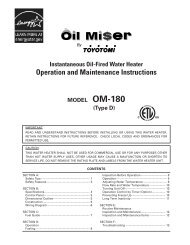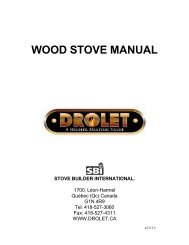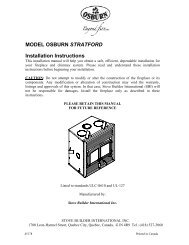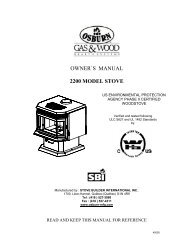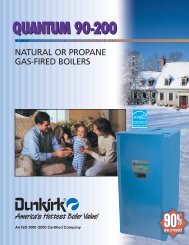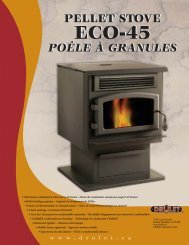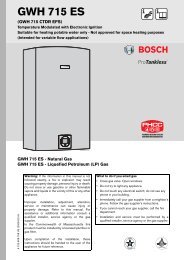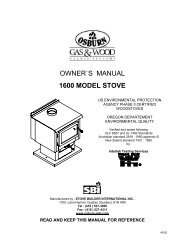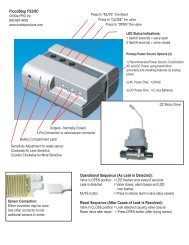Owner's Manual Osburn 1100 Wood Stove Insert - Rural Energy ...
Owner's Manual Osburn 1100 Wood Stove Insert - Rural Energy ...
Owner's Manual Osburn 1100 Wood Stove Insert - Rural Energy ...
You also want an ePaper? Increase the reach of your titles
YUMPU automatically turns print PDFs into web optimized ePapers that Google loves.
4.2 Ash RemovalCAUTION:Ashes can start fires, even after several days of inactivity. Never dispose ofashes in a combustible container. Remove ashes only when the insert andashes are cold.Ashes should be removed from the insert frequently. When ashes are removed, they should be placed ina metal container with a tightly fitting lid. The closed container of ashes should be placed on a noncombustiblefloor or on the ground, well away from all combustible materials, pending final disposal. Ifthe ashes are disposed of by burial in soil or otherwise locally dispersed, they should be retained in theclosed container until all cinders have thoroughly cooled. Do not place other waste materials in themetal ash container.4.3 Chimney CleaningRegular chimney maintenance, as well as good burning practices, are required to prevent chimney fires.The chimney and the chimney connector pipe must be maintained in good condition and be kept cleanfor optimal safety. The chimney should be checked regularly for creosote build-up. Inspection andcleaning of the chimney can be facilitated by removing the baffle.CAUTION: OPERATION OF YOUR OSBURN INSERT WITHOUT THE BAFFLE MAY CAUSE UNSAFE ANDHAZARDOUS TEMPERATURE CONDITIONS AND WILL VOID THE WARRANTY.Contact your local, municipal, state, or provincial fire authority for information on how to handle achimney fire before there is any chance that it may happen.Creosote – Formation And Need For RemovalWhen wood (especially green wood) is burned without adequate heat or air supply, it produces tar andother organic vapours (smoke), which combine with expelled moisture to form creosote.The creosote vapours condense in the relatively cool chimney flue of a slow-burning fire. As a result,creosote residue accumulates on the flue lining. When ignited, this creosote makes an extremely hotfire, which could be hazardous. Check frequently for creosote build-up. In the event of a insert orchimney component failure, replace only with equipment that is equivalent to the original, availablefrom your <strong>Osburn</strong> dealer.Your <strong>Osburn</strong> insert has been designed to reduce the amount of creosote produced. Even so, the chimneyconnector pipe and chimney should be inspected at least once every two months during the heatingseason to determine if a creosote build-up has occurred. If creosote has accumulated, it should beremoved to reduce the risk of chimney fire. Call a professional chimney sweep, or go to your local<strong>Osburn</strong> dealer and purchase a chimney brush, and have the chimney cleaned.18



